|
Appendix A: some (badly connected) thoughts upon the "theory" of go problems.
Appendix B: a few tries at (almost) rigourous definitions.
Introduction and user's guide
Why a bestiary ?
In the many years I have devoted to the game, I have collected strange situations, famous tesujis and other wonders. Some could be found in my Des manœuvres étranges (published in the French Go Review), and others were published in earlier articles, or appeared on my problem pages, but only a few of my favorites figured there. In 2005, I decided to gather them all here, but this was for a long time a work in progress (and is still somewhat unfinished :
see the list of recent additions above ; here is the complete story).
In August 2006, this bestiary was added (with slight improvements) to Games of Go on Disk (GoGoD), T. Mark Hall and John Fairbairn's project ; I owe them many new references and corrections to the anecdotes told here... During the summer of 2009, I included sgf files allowing for a much better analysis of some positions, as will be detailed below. But all this work (which is far from complete : in 2010, only the files for the first part were written) is still pehaps marred by mistakes and lack of precision ; don't hesitate sending me criticisms and comments (at
).
One of my aims in those pages was
to explain, to the best of my capacities, why those situations are noteworthy, those explanations being aimed at a level of (about) 5 kyu. Alas, solving some of those problems (or even understanding fully the solution) asks for a much higher level : Dosetsu's problem, usually described as the most difficult ever, required literally hundreds of hours to be solved by professionals ; in such cases, you cannot expect from an amateur any kind of exhaustive commentary, and even less an easily understood one ...
To compensate for this, I have also illustrated those positions with more or less technical remarks and anecdotes ; some are generally unknown in the West (which doesn't mean I have forged them  ), like the story of the shrine problem ; I hope, by so doing, that this oral tradition (a large part of which has been told to us by Master Lim Yoo Jong) will not be lost... ), like the story of the shrine problem ; I hope, by so doing, that this oral tradition (a large part of which has been told to us by Master Lim Yoo Jong) will not be lost...
One will find here wonderful positions and exquisite moves (such as Dosaku's warikomi or the external atekomi of problem II.4.4), but also situations which would rather be ignored by most players, like the (in)famous
molasses ko ; those monsters are the reason Harry Fearnley called his own collection, from which I borrowed a few specimens, a bestiary ; I must add that those problems have no real copyright (and anyway, I have some strong feelings (in French) with respect to abuses of the intellectual property concept), but I have tried, as far as possible, to give precise references ; here again, I will be grateful for any further information... Many of them appeared first in two famous classical collections, Xuan Xuan Qi Jing (Chinese, 14th century) and Igo Hatsuyoron (Japanese, early 18th century), which I will describe in more detail later, and which were already bestiaries ; I also found some of them in a set of (somewhat) easier and more practical problems, collected by Hayashi Gembi, the Gokyo Shumyo. I have not always respected the original settings of these problems, either voluntarily (for instance to show the theme without unnecessary complications) or more often because I did not have access to them ; I could now rectify this, but as, anyway, those settings often differ from one edition to the other, I feel somewhat forgiven for whatever liberties I have taken (in every sense of the word)...
Finding one's way in this maze
The classification of problems made here (and summarized in the table of contents above) is not intended to be rigid and definitive : some themes often appear as variations in problems mostly belonging to some other category ; some life-and-death problems are in fact live-or-escape ones, etc. I therefore often give cross-references : for instance, Dosetsu's problem (the most difficult ever) refers to the position known as hanezeki. As a private homage to Nicolas Bourbaki, those references are "relative" ones, i.e. Dosetsu's problem is problem 4 in its subsection, but would be mentioned (if it had no name) as problem 7.4 in the first part of the bestiary, and as problem I.7.4 everywhere else...
While most of those problems are "artistic" ones, they are still also often quite hard ; therefore, I thought it could be useful to give a (very rough) indication of their difficulty (each section ending usually with the most difficult ones); a few easy reference diagrams are not ranked, but for the others :
one  means that a player around 1k should be able to solve the problem (within a few minutes at most and without putting stones on the board); there are 53 problems in this category, means that a player around 1k should be able to solve the problem (within a few minutes at most and without putting stones on the board); there are 53 problems in this category,
two   mean (with the same conditions) a 5d level; there are 61 problems of this type,
mean (with the same conditions) a 5d level; there are 61 problems of this type,
three    mean a professional level, with no real time limits, as they are able to think efficiently for a long time... (41 problems). mean a professional level, with no real time limits, as they are able to think efficiently for a long time... (41 problems).
And, of course, Dosetsu's problem, and 12 others, not so hard, but still inaccessible to mere mortals (at least without trying variations on the board), are ranked four     ... ...
To be complete, I must add that this classification presupposes you do not have any hint other than the problem's caption (it is distinctly easier to solve a problem knowing that it uses under-the-stones play, say), and, of course, have never heard about it in advance, as could well be the case for the most famous ones, which many strong amateurs may at least already have glimpsed in some book or magazine ; this explains why some problems (especially those of section I.5) are hard to rank ; in those cases, I have used marks like    (?), for instance. With these provisos, for a kyu player, solving a (?), for instance. With these provisos, for a kyu player, solving a   problem is a performance which he could legitimately be proud of... problem is a performance which he could legitimately be proud of...
User's guide
Problem solving is usually supposed to improve the practical level of players ; many collections of problems are introduced by hints for good use. Two quite distinct approaches are to be found (which does not mean they are mutually exclusive) : Chinese players suggest that you should look at a large number of positions as fast as possible, look then at the solutions, try to find them again some time later, and so on, until the eye and the brain get accustomed to see immediately the correct move or sequence ; some Japanes pros, on the other hand, will tell you to stay on a problem until you have solved it completely (which means you have considered every possible resistance, and perhaps even refutated every wrong solution). But anyway, everybody agrees to say one must not put sequences on the board (except those of the initial setting). Actually, for training purposes, one should not even need the captions : in a real game, nobody stands at your shoulder to tell you that this group can be killed, or that this other one can connect to the outside... So, if you would rather see those lists as sets of problems to be solved, you will find them there, with only the captions (like "Black to play, status ?" or "White to play and escape") ; but of course, some of the problems I show here are so hard that it would be somewhat absurd to try to solve them by following those recommandations to the letter, except for professional players ; to appreciate these masterpieces, it is probably better to try some variations before looking at the solution (which will often be not too easy to understand even after those tries).
Alas, the solutions given here as static diagrams allowed me only to give but a few variations, not to mention the fact that for under-the-stones solutions (and for some other very long ones), they were almost useless ; I had tried to improve this by
using the Java applet of Hiroki Mori, to give animated variations (clicking on the corresponding link will open a new window using it), and some of those problems be found on other sites, like the GoProblems site ; when appropriate, I also gave a link towards their solutions.
But during the summer of 2009, I began to included sgf files which you can open by clicking on the highlighted part of the caption (at least if your browser is correctly parametered ; the happy users of GoGoD will probably choose to read those files with Pbase, for the others, Cgoban should probably be give good enough results) ; those files include the solution, main variations, refutations, and some additional comments.
In those files, the moves are ranked from best to worst (which may not be the most appropriate order for teaching purposes)
; to be precise, in a "Black to play and kill" problem, the first black move shown (the highest in the tree) is the right answer, and the second (just below it, therefore) will perhaps kill only by ko, while white answers (all failing to live) will be ranked according to the resistance they offer (forcing Black to find harder tesujis, or longer sequences) ; it could be helpful to read also some of the remarks in the annex. An example will allow the reader to compare both approaches : I could only give three diagrams, covering only one variation, of the solution of problem I.3.8 (a quite artificial double ishinoshita), where the sgf file shows a dozen lines of play, moreover much easier to follow that way...
To conclude, the diligent reader will probably best enjoy those problems by trying first to solve them without any help, then by having a look at the solution diagrams, and last by exploring the variations of the sgf files ; I tried to be there as exhaustive as possible (except for the most difficult problems), so if you still find something unclear (or perhaps wrong), do not hesitate to write (at
)...
For many years, I have shown some of those positions to every interested player I could catch (and to many others  ) ; I was often disappointed to see that, far from trying quietly to solve my beautiful problems for themselves, some of them insisted on putting their hands (and their stones) on my positions. For those troublemakers, I constructed the problem below, which no one has yet dared to disturb physically with his tries, and which will therefore make a fitting (and personal) introduction to this collection... ) ; I was often disappointed to see that, far from trying quietly to solve my beautiful problems for themselves, some of them insisted on putting their hands (and their stones) on my positions. For those troublemakers, I constructed the problem below, which no one has yet dared to disturb physically with his tries, and which will therefore make a fitting (and personal) introduction to this collection...
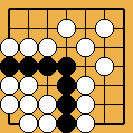
 Appetizer : Black to play ; status ? Appetizer : Black to play ; status ?
(click here for an sgf file of the solution)
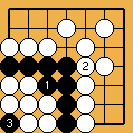
Solution (1) : the first moves are not surprising...
|
|

Solution (2) (9 at 5, 10 at 3) : Black lives in indirect ko (mannenko)
|
I. Extraordinary life and death problems.
Problems in this first section are classed by themes ; one of their common features is the exceptional rarity (to say the least) of most of those themes in actual games (except for the problems of section 6)... First, let's look at some symetrical positions, trying not to disturb them (as suggested by the proverb telling to play on the axis of symetry) ; it must be admitted they are not all about matters of life and death...
1. Symmetrical problems
French go was really set on its tracks, in the early 70"s, when Master Lim Yoo Jong decided to lavish his considerable pedagogical skills on the rank beginners the handful of French players were then. Besides teaching us shapes, josekis, etc.,
this strong 5d at first created for us many miniature problems (similar to examples 3.1 and 3.2), but we had to wait for many months before being worthy of the marvels he knew.
Problem 1 was the first really pretty thing he showed us.
Back then, I could not believe anyone had enough imagination to compose something like that (even solving it felt impossible  ). I was even more astonished when he told us it appeared in the oldest known treatise of the game, but in fact this story was an oversimplification : the Xuan Xuan Qi Jing, title prettily "translated" by John Fairbairn as Gateway to All Marvels, is not the oldest treatise (it is predated by Donhuang Classic, for instance) ; it is actually a compilation from the 14th century, with many variants, including the famous Japanese version known as Gengen Gokyo ; here is a collection of all the problems in the Chinese edition, and there an "sgf" file including solutions, which can be read using Kombilo. These compilations include many problems almost certainly much older, as the Xuan Xuan Qi Jing records also very spectacular games (even is some of them could be faked ones) which are supposed to have been played even before the game was known in Japan, circa 600 AD. The key of problem 1 (an "off-limits" move) is anyway quite astonishing (and not only for beginners ; I still find it impressive after all these years), and shows indeed a surprising level of technical sophistication for such a remote past... ). I was even more astonished when he told us it appeared in the oldest known treatise of the game, but in fact this story was an oversimplification : the Xuan Xuan Qi Jing, title prettily "translated" by John Fairbairn as Gateway to All Marvels, is not the oldest treatise (it is predated by Donhuang Classic, for instance) ; it is actually a compilation from the 14th century, with many variants, including the famous Japanese version known as Gengen Gokyo ; here is a collection of all the problems in the Chinese edition, and there an "sgf" file including solutions, which can be read using Kombilo. These compilations include many problems almost certainly much older, as the Xuan Xuan Qi Jing records also very spectacular games (even is some of them could be faked ones) which are supposed to have been played even before the game was known in Japan, circa 600 AD. The key of problem 1 (an "off-limits" move) is anyway quite astonishing (and not only for beginners ; I still find it impressive after all these years), and shows indeed a surprising level of technical sophistication for such a remote past...
What would I have thought then if our master had shown us "the mask" (my personal nickname for problem 2) ? I stumbled on it while browsing the Korean version of Xuan Xuan Qi Jing (where it is called Pearl Neck Fringe ; we will see that many of those old problems have poetic names, which are also at times hints toward their solution) that Janice Kim had brought with her during the junior world championship in Paris, in 1985. She had never seen it, and nobody was able to solve it, except for one of the Chinese pros (who glared at it for almost one hour) : it seems that the real difficulty is to see (without moving stones, of course) that one must break the symetry at move 31...
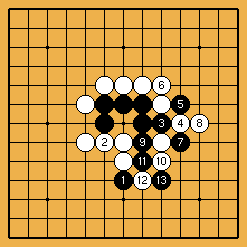
Solution 1 : the key move at 1 (an "off-limits" move)
is a probe opening two doors ; if instead one simply pushes ...
|
|
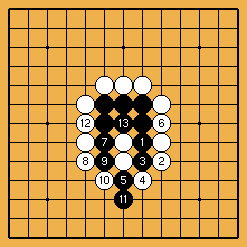
Black finds herself short of liberties (14 above 5)
|

Solution 2 : Phase 1 : threats of ladders
(I will let you look for them ; actually, there exists a Japanese version of this problem where they are constructed to be as tortuous as those of section III )
|
|
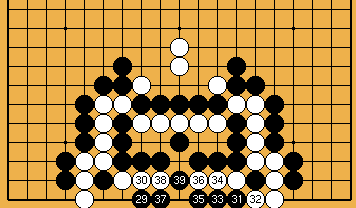
Phase 2 : first line footwork
(note the partial breaking of the symetry, perhaps unnecessary ; the theme appears at last, as 39 is a decisive double threat)
|
The next four problems are definitely easier...
Problem 3 is a classical one from Xuan Xuan Qi Jing (a variation on the "goblin's long nose tesuji", known in that case as the Cooked Goose problem) which Michael Redmond was especially fond of, as he did play it once in a game (it is distinctly harder to solve when not given as a problem, and a symmetrical one at that ...) Problem 4 is artificial, of course, but really funny. And problem 5 (known in the Xuan Xuan Qi Jing as Bright Pearl comes out of the sea, and not so easy) is here to show that the solution is not always the symmetrical move. Last, problem 6 (which is not a life and death one) exhibits an astonishing yose move in a quite natural position, which would be rather difficult to discover in a real game...
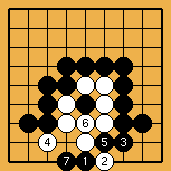
Solution 3 :
1 is the only move preventing a ko fight
|

Solution 4 : move 1 is necessary to prevent White
from escaping on the 2nd line
|
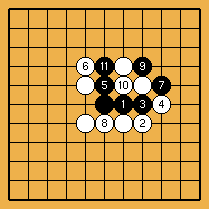
Solution 5 : nothing else prevents shortage of liberties
|

Solution 6 : move 1 threatens the two cuts
|
Back to the table of contents
The following sections explore sacrifice plays (these have always been my favorite ; I wrote a few articles on this theme in the early French Go Review, but they seem to be lost, and would only have historical value nowadays...)
2. Snapbacks (uttegaeshi)
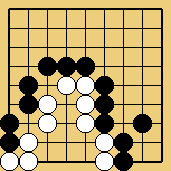
 Problem 1 : Black to play and kill Problem 1 : Black to play and kill
(click here for an sgf file of the solution)
This is a kind of sacrifice, but a very short-lived one... They are not always easy to anticipate, as shown by the nice problem 1, from a recent Chinese beginners' collection (yes, their beginners are not made of the same stuff as ours...)

Solution 1
The "slow" key is hard to find (it is almost an "off-topic" move), especially if you have never seen the subsequent snapback combination ; below the 3k level, players often are lured by similar invisible snapbacks. You could have sworn that, after 2, the white group had three eyes and no weaknesses, didn't it ?
Double snapbacks are more fun (the previous problem was not an example) : first, problem 2, a miniature problem with a maximum of snapbacks in a minimal space, then problem 3, displaying the theme with the largest captures (there is no similar combination with chains of three stones). and last, problem 3, a personal improvement of an exercise in Xuan Xuan Qi Jing, showing a cut which will see again (in problems 6, 9 and III.3)
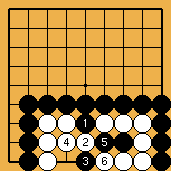
Solution 2 (7 at 5)
|
|
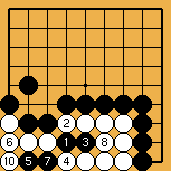
Solution 3 (9 at 1, 11 at 7)
|
|
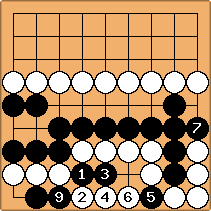
Solution 4a (8 at 5)
|
|

Solution 4b
|
Those are called "crossed" double snapbacks, which I felt somewhat redundant, until I met a few nice problems, like this miniature created by Yang Yilun
Now, two classics, a more recent creation, and last, from Hatsuyoron, the most difficult problem on this theme.
Problem 6 is another Chinese classic (from Xuan Xuan Qi Jing), with a lost-wax process theme (i.e stones are put there just to create a shortage of liberties, after which they are sacrified) ; it is also one of those problems where the order of moves is essential, which is not too common. The pretty problem 7, also a lost-wax one, looks almost like a triple snapback.
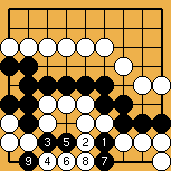
Solution 6 (beware of the order of moves)
|
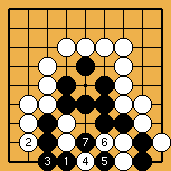
Solution 7
|
Published in Kido (the strongest Japanese go magazine) in 1996, in the monthly problem-solving competition, problem 8 ends in a parallel double snapback ; it is hard to solve correctly, as the ko resistance looks irrefutable...

Solution 8 : this splendid "parallel" double snapback
kills without ko ...
|

Variation : it was not easy to see how to prevent this ko...
|
Last, problem 9 (from the Hatsuyoron, which may explain why it's not really a life and death problem) displays the theme in an expanded version, but it becomes then almost impossible to solve without putting stones on the board, especially because of the many intentional wrong tracks, and of the hidden last "slow" tesuji. The strongest White resistance in fact ends in a (very) indirect ko, but in a real game this resistance, endangering the whole group, would certainly not be White's best choice...
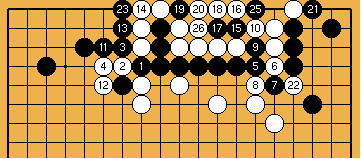
Solution 9 (24 at 19, 27 at 15) : note the "slow" move 21
|
|
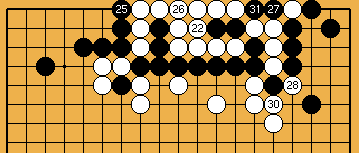
A variation without snapbacks, but with an elaborated twist on thieves' play (23 at 15, 24 at 17, 29 right of 27) ; White can in fact resist with yoseko, by playing 24 at 31, but ...
|
Back to the table of contents
Next, we are going to meet some sacrifice techniques amateur players never seem to find in their games...
3. Under the stones (ishinoshita)
In the open space freed by a capture, possibilities of cuts may sometimes appear. The three small problems above (perhaps not so easy as you would think at first sight) are thematic examples of the different shapes letting this happen...
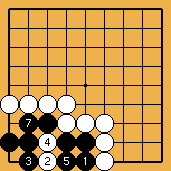
Solution 1 (6 at 4, 8 left of 4) |
| 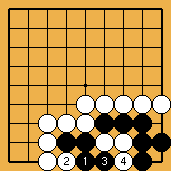
Solution 2 (5 above 1) |
| 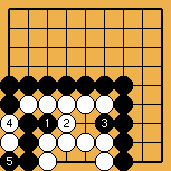
Solution 3 (6 at 4, 7 below 4, 8 at 4,
9 right of 4)
|
Next, two applications (from Xuan Xuan Qi Jing) whose solutions many quite strong players have missed.
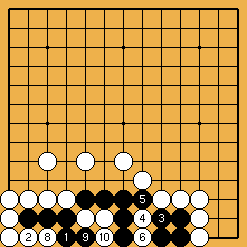
Solution 4 (7 at 3, 11 above 1) | 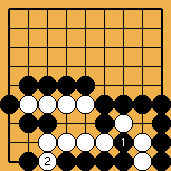
Solution 5 : first, an unusual sacrifice
(it will reappear in the next subsection) |
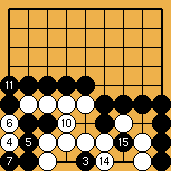
Solution 5 (follow-up)
(8 at 6, 9 at 4, 12 at 6, 13 right of 6) |
One could easily believe that the shapes involving this tesuji are too artificial to appear in real games. The yose position above, therefore, must be quite often misplayed. Chinese players know the corner shape as "chicken on one leg", but they are probably not often aware of this particular situation...
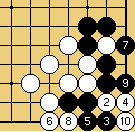
Solution 6 : because of the under-the-stones resistance (11 to the left of 2), White only gets 3 points more than by playing the hane at 8 ; on the other hand, if Black misses it and answers meekly at 4, the cut gets 9 points more than the hane (but is gote) |
Now that the trick has no mystery left for you, three harder problems ...
I always had a soft spot for problems 7 and 8, old Chinese classics with highly artificial settings (the first being from Xuan Xuan Qi Jing, with a shape we will meet again in the next section, in problems 4.6 and 4.7), whose theme is mostly "one ishinoshita may hide another" ; I often used them as reading benchmarks, 6d usually solving them in a couple of minutes, while lesser beings get into trouble... Nevertheless, nothing could top, in this vein, the astonishing problem 9, found by Nakayama in a shrine (it seems that composition of this kind of puzzles, and (in fact, more often) of geometrical problems, was a hobby popular enough to give rise to their use as votive offerings, under the name of sangaku, i.e. "calculation tablets"). This one indeed had merits enough to be saved from oblivion, and one can only wonder at the skill of its anonymous maker, who doesn't satisfy himself with the almost triple ishinoshita used to construct the first eye in sente, but carry on with a classical (though a quite pretty one too) destruction of the second eye... which fails, thanks to another unusual corner tesuji (a favorite of André Moussa, which Hikaru's fans will perhaps recognise)

Solution 7a | 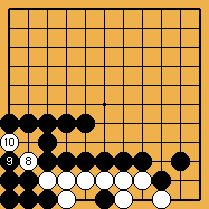
Solution 7b | 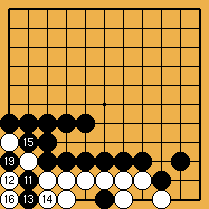
Solution 7c (17 at 11, 18 at 13)
|

Solution 8a (7 left of 2) | 
Solution 8b | 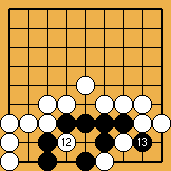
Solution 8c |
In a somewhat different (and even more artificial) style, I stumbled recently on this bewildering Japanese composition, which should perhaps appear in the next section :
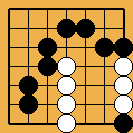
   Problem 10 (another highly artificial one) : Black to play, status? Problem 10 (another highly artificial one) : Black to play, status?
(click here for an sgf file of the solution)
An incredible sequence of turnarounds ...
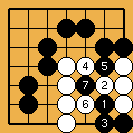
Solution 10 : first surprise...
|
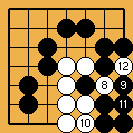
Second surprise : Black declines the ko fight ...
|

... and kills without ko
|
|
To conclude this part of the section, here is, I think, the most astonishing ishinoshita played in a real game (or so did our master tell us). Actually, it is quite possible that this position (shown to us by Lim Yoo Jong, but coming, after some modifications, from the Xuan Xuan Qi Jing, where it is called Golden Cicada Casting Off Its Shell) was in fact "improved" from something really played (many "urban legends" of go (or weiqi) lore are of this type, for instance the one of Dosaku's tesuji). Anyway, the (hard to believe) story Lim told us was that in the position on the right, White, fighting for an important outside ko (not shown here) had deliberately ignored the ko threat (the triangled stone) and filled the ko, reading the resurrection of his group in another ko, and the fact that Black would not have any further threats. The solution given below is perhaps also not completely correct (see the annex for more remarks on this), and I let the diligent reader decide, for instance, if move 14 is really necessary, or is just losing some yose...
| |
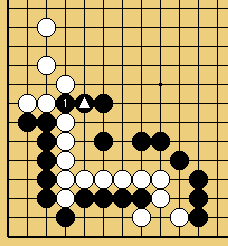
   Problem 11 (from a real game ?) : could White really afford to ignore the ko threat ? Problem 11 (from a real game ?) : could White really afford to ignore the ko threat ?
(click here for an sgf file of the solution)
|
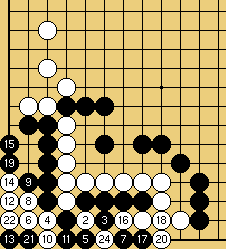
Solution 11 : after the best resistance at 7 (in the other variation, 7 at 8, White get an easier-to-spot ko, but it is a two-step one, actually better for Black that the one of the "solution" : 7, 24, 11, 10, 21...), it ends with an under-the-stones tesuji (23 at 21, 25 at 7, 26 at 17, 27 at 13) ...
| | 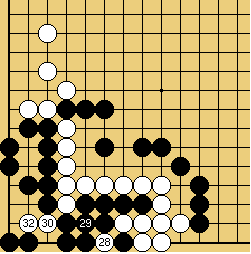
...and Black must find the first ko threat to take back 28 (if she connects at 29 as shown above, 31 takes back the ko to the right of 28, but 32 captures all the stones unconditionally) ; moreover, 30 is an intrinsic ko threat. |
Even less known than under-the-stones play, its threat (for which I suggest the name of "virtual ishinoshita") may be enough at times to save the day...
In the thematic example at left (where a liberty at a is necessary, a fact which was brought to my attention by Pierre Colmez), there is only a threat of under-the-stones play ; we will see another nice example with problem II.2.7, but there it will not be the main theme. Problem 13 is the strangest example I know of this idea ; I found it in a tesuji dictionnary compiled by Fujisawa Hideyuki (better known as Fujisawa Shuko, as explained in this article of Sensei's Library), amongst much easier problems, and it could also appear in my section on traps for professionals : some 4 dan pros have fallen for it (the trap is that it looks hard enough, so, after discovering the virtual ishinoshita, it seems solved, even more so if the amateur player who shows it to you looks harmless...)
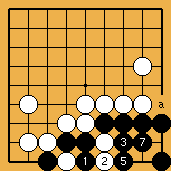
Solution 12 (the thematic manoeuvre) : 4 captures (left of 1), 6 (above 1) is forced. | 
Solution 13 (10 left of 3) : White lives in ko |
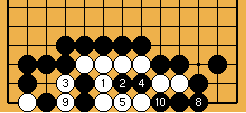
Variation 13 (6 at 4, 7 at 2): If White tries for unconditional life, he dies without ko ! |
Back to table of contents
Now, for a quite different kind of under-the-stones play...
4. Eye reduction (nakade)
Nakade is the Japanese name of the destructive plays in the middle of the eye-shape of some group, a special case of under-the-stones play indeed, but quite a trivial one... except if the shape is at first sight too large to be killed (more than 3 aligned spaces, or 6 in any shape : all 7-space nakade shapes are alive, at least in seki), or if the move has more than one objective. An example has already appeared in problem 3.5, with its strange 5-stone sacrifice ; this possibility becomes a blind spot for almost all non-beginners (I sadly remember having lost a group that way against Jeff Seailles while playing a French Championship round), and the following problems are, therefore, quite difficult if you are not given this hint...
At first sight, it seems that White had no reason to protect against the cut in problem 1. Problem 2 (which combines a few nice themes besides this one) is part of the recent Korean training collections, and even after you find the right attack, a White resistance in ko will look hard to counter...

Solution 1 : the 5-stones-in-a-row capture is not enough to live... | 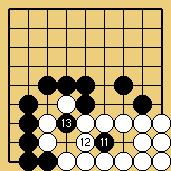
... as shown here, so White had better play 2 at 3, for a ko
|
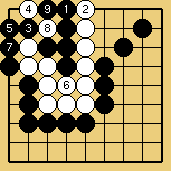
Solution 2 (8 at 6, 9 at the centre of the T-shape) : Black can decline to
play the ko (right of 4), as the 6-stone capture is not enough to live... | 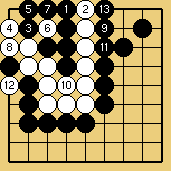
In this easier variation, White loses the race by one liberty. |
Next, a miniature problem (from the same "beginners' book" mentioned in the snapback section) showing a double purpose nakade, and a much harder problem on the same theme.
The ko in problem 3 looks at first sight unavoidable, as how could one sacrifice the four stones ? Many themes appear in problem 4, which comes from one of the classical Chinese books, but which I discovered in Paris tournament 1993, when one of the Dutch players teased everyone with it. It is incredibly hard for something so close to a classical J-group shape...

Solution 3 (1 connects, then Black sacrifices the 4 stones) : after 5, it becomes clear there is no way to form the second eye | |
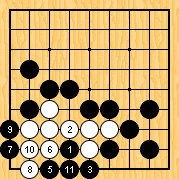
Solution 4a (4 at 11) : after capture, Black plays back at 11 ; I let you finish, using diagram 4b...
| |

Solution 4b (4 at 9) : same shape, on the other side
|
Another little-known situation is the sacrifice of a L-shaped string of four stones, when the return strike at the vital point not only reduces the shape to one eye, but does it in sente, as it threatens a snap-back.
Problem 5 appears in another Chinese training collection (designed for more advanced players, it must be said) and you should be quite strong to kill without ko were you not given the nakade hint ; problem 6 is a famous one from Xuan Xuan Qi Jing, with a shape similar to the one in the previous section but not looking so hard, except that it is full of traps, including the temptation of the same nakade. Studying it again after all those years, I discovered to my own surprise the "improved" variation 7, where the theme is no longer virtual...
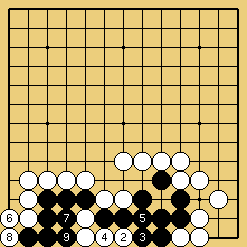
Solution 5 : after capture... | 
...playing at the vital point threatens a snap-back |

Solution 6 : after the atari at 10, | 
Black must resort to ishinoshita tactics
(13 right of 3), else... | 
...the vital point proves lethal |

Solution 7 : now, Black can no longer
connect (left of 9)... | 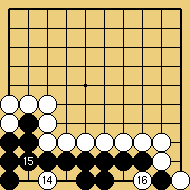
...and is killed by the nakade |
Now, some block sacrifices.
Problem 8 is one of the easiest in
Hatsuyoron (which may help you get a feeling for the level of the others), but it has the additional merit of the almost unheard-of theme of eye-destruction... of the attacking side. Problem 9 is a recent Chinese improvement on it, with a difficulty approaching that of problem 2...

Solution 8
| 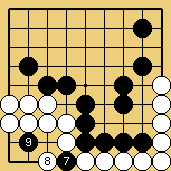
Capturing 7 stones is not enough to live
|

Solution 9 (9 at 6, filling his own eye) | 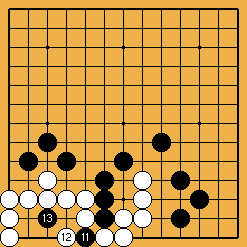
Capturing 7 stones is not enough to live |
The shapes of the following problems are much more contrived ; they all come from Hatsuyoron, where a special section is devoted to many more examples...

  Problem 10 : Black to play and kill. Problem 10 : Black to play and kill.
(click here for an sgf file of the solution) | | In problem 10, one of the largest centre nakade shapes, you will perhaps notice that the group of problem 1.1 even when it doesn't succeed in escaping, is without doubt quite tenacious ; actually, even if Black doesn't find move 3, life for White is not so easy to achieve, as will be seen in the joint sgf file... |
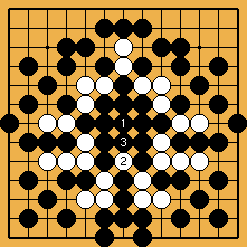
Solution 10 (4 at 2) : The 14 stones capture isn't enough to live | | 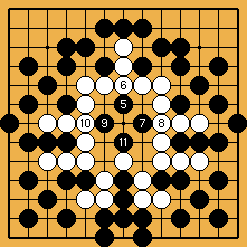 |
UPDATE ! (15/11/2009)
The two new problems above, displaying 18 stones captures (therefore improving Robert Pauli's record), appeared at Sensei Library in september 2009 (and were brought to my attention by the ever vigilant Thomas Cabaret); while problem 12a is still linked to Dosaku's shape (which doesn't mean it is not already a wonderful discovery), problem 12b uses shapes (and ideas) which I believe are quite new in this context ; are we really close now of the maximal size for this theme ?
The following problems will show that, if one doesn't ask for the capture of only one block, much more incredible tasks are possible...

   (?) Problem 13 (the bait swallows the fish) : White to play and kill every black stone. (?) Problem 13 (the bait swallows the fish) : White to play and kill every black stone.
(click here for an sgf file of the solution)
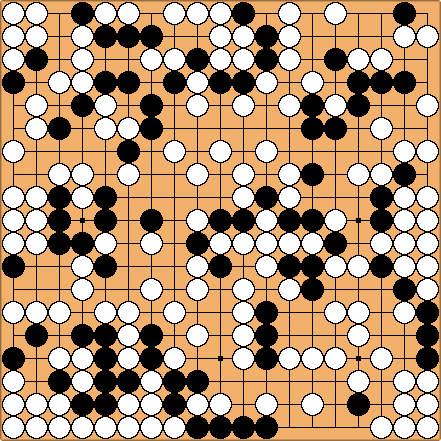
    (?) Problem 14 (improvement due to Akaboshi Intetsu) : White to play and kill every black stone. (?) Problem 14 (improvement due to Akaboshi Intetsu) : White to play and kill every black stone.
(click here for an sgf file of the solution)
| | Problem 13 is also said to have been created by Dosaku, but is more probably a Dosetsu composition, and appears, of course, in Hatsuyoron, as I will explain below. I discovered it first in the Nakayama's book, "The treasure chest enigma" ; its nickname in that book is "the bait swallows the fish", and its incredible theme is the capture by the same black group of 75 white stones (coming in 9 different shapes), but nevertheless this group ends with only one eye !! The "improved" variant of problem 14, with 83 stones sacrificed (and interesting difficult variations ending the sequence ; I tried to show all of them in this sgf file) comes from Genran ("Glimpses of the Mysterious", what a tantalising title), a Japanese compilation by Akaboshi Intetsu (circa 1830) ; it is, appropriately, the last problem of the book, but Genran contains some other quite spectacular problems, like a whole-board seki , and a whole-board ladder problem starting from a 14-stone nakade ; both will be found in part III.
Here is a good opportunity to describe in more detail Igo Hatsuyoron (this title means something like "On producing Yang (tactics) in Go", but I would not hesitate, tongue-in-cheek, to "translate" it as "The Dark Side of the Force"), a compilation by Inoue Dosetsu Inseki (in the late 18th century) of the hardest problems he knew. Astonishing marvels fill its pages (we have already seen a few ; on the site of Sensei's Library, you will find a complete list of those problems, with detailed solutions for some of them ; here are, alas in Japanese, animated solutions) ; problem 13 figures there, of course, and was for a long time thought one of the most wondrous compositions of the collection, but we will see that problem 7.4 stands far above it (known as "the most difficult ever", this problem appeared in the original edition, but, perhaps because of its tremendous complications, it was apparently lost, and was recovered only in 1982...). It is now well-established that most of the Hatsuyoron problems were created by Dosetsu himself (perhaps with the help of his pupils) ; for a long time, this compilation was then used as (secret) training material for the best disciples of the Inoue house, who, says the story, were only allowed to stare at the currently opened page of the book until they found the solution, winning in this way the right... to turn the page. At the start of the twentieth century, the book lost its secrecy, and four Japanese editions (the last one in 1982) were published, with solutions included... but those problems are so hard that many mistakes crept in, and Chinese and, more recently, Korean professionals were delighted to publish revised editions, where they harshly criticise some of the previous analysis... |

The solution above is, of course, barely readable ; so, if your eyes get tired, you will probably be grateful to
click here for an animated solution, or for the associated sgf file ; it is also displayed, in a more detailed version, on the site of GoProblems, but their solution doesn't mention all variations ; for instance, I owe to Motoki Noguchi the sequence showing that the last sacrifice of 6 stones in the NW corner is actually necessary. On the other hand, the solution I give (in the associated sgf file) of the Genran problem, is all mine, which could explain some of its defects...
|
Back to table of contents
5. Blind spots
I only know two examples of this phenomenon (problem 3.13 is not exactly in the same category) : the stronger you are, the harder will you find it to solve these problems .
The first one (problem 1) gave its title to Nakayama's book "The treasure chest enigma". I had lost the book, and it seems to figure nowhere on the Web (Didier Hallepée, one reader of the first draft, was kind enough to send it to me) ; I had composed a variant with some mistakes (now corrected), which were found by Didier Hallepée and Pierre Colmez, but I don't know if it is as difficult as the original problem (I suspect it is, as Pierre and I already fell into many traps while solving it ... ). The blind spot seems here to be Black's damezumari in problem 1 (curiously hard to see in this unusual shape) ; trying to solve it (without putting stones on the board, of course), professionals (and strong amateurs) forget this "detail", where weaker players don't encounter any special trouble.
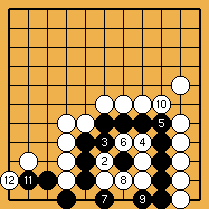
Solution 1 : Now, at last, you should see why it is Black who is dead...
| |

Solution of the variant : White dies for the same reason
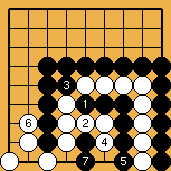
This way too ...
|
|
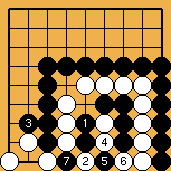
Starting this way, the best White defence leads to a ko
(while we are at it, did you see what role the 1-1 stone played?)
|
The curious problem 3 has tricked many pros (including Yi Ch'ang-ho) ; there again, the theme is so surprising, and so unlikely to be found in a game, that they get carried away by their reflexes, and miss (or more precisely bypass) the solution, which is yet not so hard for weaker players...
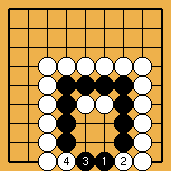
Solution 3 : if Black stops playing at this point, she lives (in seki), but adding one more move is suicidal ! By the way, this seki is so unusual that the (old) Ing rules could not decide its value for Black (2 points ?), but anyway, they were modified after V.Gurvitch discovered the other strange sekis we will see in section IV...
|
Back to the table of contents
6. Reference problems
In this penultimate section, I mention positions every player (according to his or her level) knows (or should know), carefuly classified by Davies or Cho Chikun. Nevertheless, in those reference books, some classical shapes are missing (or worse, mistakenly treated).
Problem 1 was Saijo Masatoka 8-dan favorite workshop problem ; this position can appear quite naturally in a common invasion at sansan, and in a pincer joseki on the 3-4 point (also quite common) ; according to Saijo Sensei, every dan player should know it (or at least be able to find the solution), but I have not seen many European 5 dans solving correctly all variations, especially the second one, with its three slow moves...

Solution 1 : variation 1 (if White 4 at 11,
Black pushes left of 3, and the L-group is dead)
|
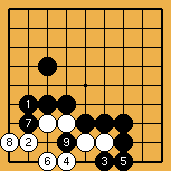
Variation 2 (this defence is the hardest to refute ;
if White 6 at 7, it reverts to variation 1)
|
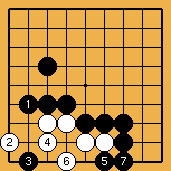
Variation 3 (easier)
|
Problem 2 has a quite natural setting, appearing often in actual games (but not so often with this exact configuration). Nevertheless, the solution given in most reference books is wrong ; by an incredible coincidence, the correct answer was found in the same year by Japanese professionals and by Thomas Wolf's tsumego program ; the program also found a few other extraordinary moves, mentioned in my computer article (in French), the funniest being surely move 2 in problem 3, which, as unbelievable as it looks, is a defense as valid as the better-known other 1-2 point...

Solution 2 : the traditional answer :
White lives (in seki)...
|

... is in fact wrong : Black can get an indirect ko (mannenko)
after the "slow" tesuji 3 (another blind spot)
|
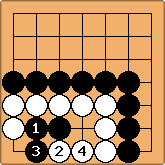
Solution 3a : White still lives (in seki, without any ko)... ...
|
|
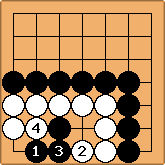
Solution 3b : ... against all black tries...
|
|
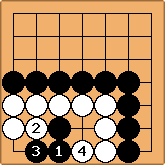
Solution 3c : ... even this one.
|
Problem 4 (and its more sophisticated variant, problem 5) are famous classics (of dan level difficulty), but I have never seen problem 6 in any book (the position comes from an erroneous attack in problem 4, attack which, on the other hand, I have often seen played) ; I also never could decide which of the two lines of attack is better (given a large enough set of medium-size ko threats) : it seems that the necessary theory is too hard, even for pros...
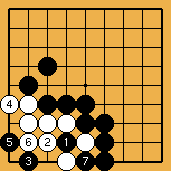
Solution 4
(dead by "bent four in the corner")
|
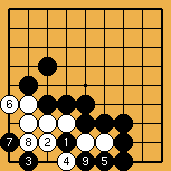
Solution 5 : idem
|

Solution 6a : mannenko
(or ten-thousand year ko, or permanent ko, the later being my own translation)
|
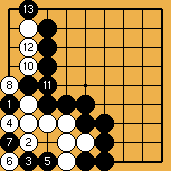
Solution 6b : another very indirect ko
(9 at 6)
|
And now, for the ultimate reference problem...
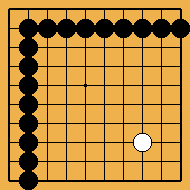
  Problem 7 : Black to play and kill the white stone Problem 7 : Black to play and kill the white stone
(click here for an sgf file of the solution)
Death of the white sansan facing enough black influence is a little known fact, one of the reasons being that the way to kill is not obvious : experiments show that, against a player giving you 4 handicap stones, his sansan will live more often than not... Moreover, it seems that pros recently found a way of living for White in the 9x9 square, which is the reason I only show here this problem in a smaller space...
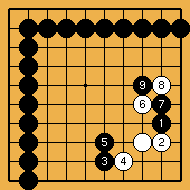
Solution 7 : One must not get too close ; after these approaches, the L-group is dead ...
Back to the table of contents
Most difficult classical problems
To end this first part with fireworks, here is a selection of very hard (and beautiful) classical problems. Dosetsu's problem apart, it may be that your mileage differ (I will consider similar questions again in the appendix) ; the problem of how to play optimally starting from an empty board is usually perceived as a quite tough one too...
Problems 1 and 3 come from the Xuan Xuan Qi Jing ; those two problems were (respectively) called empress and emperor of life and death problems by Master Lim, who thought they were the hardest ever made. Let's first unveil the charms of the empress ...
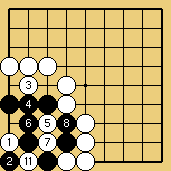
Solution 1 (9 at 7, 10 at 5)
|

This alternative solution (7 at 3) could explain
the bamboo joint in the variant
|
The solution to problem 1 above (also known as Five Tigers Trapped in a Pitfall in the original Chinese editions) is made exceptional (and exceptionally hard to solve) by the extraordinary intermediate move 3 (though the sacrifice sequence is not dull either) ; I have also shown the Japanese setting, probably designed to prevent the alternative solution (at the cost of move 3 becoming slightly less hard to spot) ; on the other hand, as the ko of this variation, already quite hard to find (especially because of the hidden tesuji at 8 ; the variation was discovered by Philippe Biane, a pupil of Pierre Colmez, and I have seen it mentioned only in recent Chinese commentaries), is in fact less favourable to White, one might think that the original problem is actually richer, and I would easily give it first prize for simplicity of setting compared with difficulty, were it not for the existence of problem 2 ; you will find other thoughts on these matters at the end of these pages...
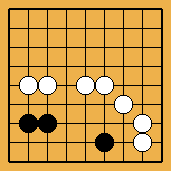
   Problem 2 (a serious contender for the throne) : White to play, status ? Problem 2 (a serious contender for the throne) : White to play, status ?
(click here for an sgf file of the solution)
There are other quite difficult problems in Xuan Xuan Qi Jing, for instance the one above, with its innocent-looking shape, but whose solution (by Japanese rules, a draw by repetition) is almost impossible to guess (not least because the first six moves get harder and harder to find) : Haruyama Isamu, one of the best pro tsumego experts, confesses to having spent six hours solving it (without putting stones on the board, of course) and believes no amateur would ever succeed, were he to spend weeks or even months on it ...
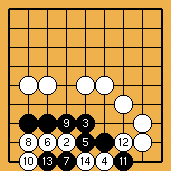
Solution 3 (15 at 7) : a "superko" (chosei)
As for problem 3, the emperor of tsumego (Large Coral Dredge in Chinese), we will see it is indeed in a category of his own. I needed more than thirty years to get what I thought then to be a complete solution, but in 2005, some professional players made me notice that move 40 was not really necessary : it is possible to catch Black in a net (this, alas, is not the coral dredge, as this refers to the Black shape...) by playing at 53 instead ; this is the reason I added the marked stone in the variant I propose, but I had therefore eliminated all difficulties : I was still discovering new variations during the summer of 2009... when the incredible tesuji explained below was found, putting an end to those studies ; enjoy first, nevertheless, what was the classical solution, with, for instance, the acrobatic ending below, shown to me by a Korean pro. Of course, what makes this problem a masterpiece of composition is the unthinkable move 16, the slowest tesuji of my collection ...
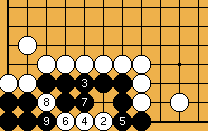
Solution 3 : Phase 1 : a multi-stage ko is created (10 at 8)
|
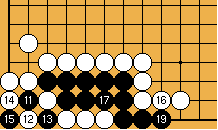
Phase 2 : destruction and recreation of ko threats (18 at 12, 20 at 8)
|
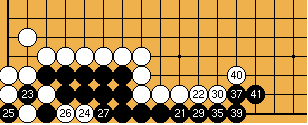
Phase 3 : Black appears to have escaped... (28 at 12, 31 at 25, 32 at 26, 33 at 24, 34 at 12, 36 at 8, 38 at 26)
|
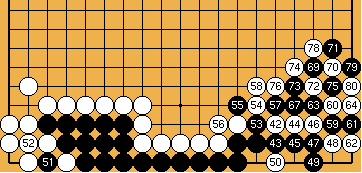
Phase 4 : last struggles (65 at 59, 66 at 61, 68 at 59, 77 at 72) , but more complicated variations are possible with the marked stone in place
|
As I said above, the net at 53 looks like a simpler way to catch Black ; this is the reason for the marked stone (left of 55) in the variant, which I believed prevents any simpler capture sequence than the one shown and doesn't hinder that one; the reader will see my analysis (of 2009) in the accompanying sgf file; it had been partially checked by Motoki, but I was still discovering new variations in 2009. If all this was correct (it was not : in 2010, Fan Hui discovered another weakness in those analysis), I could proudly present the problem with an "improved" caption : "This problem has been found on an old torn manuscript, with the information 'White to play and kill' ; what was the size of the go board ?", as you may now notice that Black escapes on any other size than the standard 19×19...
But in the summer of 2009 at the EGC (in Groningen), a suggestion which I had believed for so many years to be a urban legend (of British origin) reappeared : why should not Black push once more on the first line, for instance by playing two consecutive ko threats ?. This preposterous idea (which White cannot counter by declining to play the ko in the normal way too, as he need his threats to reduce Black liberties) had apparently been missed by everybody : one must recall that this exact sequence was explicitly refered to by Go Seigen and Kitani Minoru, during one of their famous games (Kitani was using a two-step ko to play devastating yose on the first line, and Go Seigen muttered "Xuanxuan Qijing", to the merriment of his opponent). It demolishes the original problem (Black succeeds in getting close enough to the corner to live there) and my pretty variations, but, with the help of Fan Hui, I was able to save most of it, by the following variant, which I now believe to be the only legitimate heir to the emperor :
A few new wondrous sequences appear in this variant, for instance the nice secondary problem above, another wrong try by Black, whose refutation (an off-limit belly tesuji) was given to me by Fan Hui. I could not yet show this problem to other professionals, but (if there is no other mistake left) this problem appears now to be of a difficulty only fit for an emperor...
... nevertheless, the reader will probably have already noticed that problems of the Hatsuyoron are, as a rule, rather harder than those of Xuan Xuan Qi Jing, and it is not so surprising that the present title-holder was at last found in the former collection. It figured actually already in the original edition, but, perhaps because of its extreme difficulty, it seems to have been lost, and found again only in 1982, when Fujisawa Hideyuki (better known as F. Shuko in Japan, and Kisei at the time) was asked for a commentary of an old copy just then rediscovered. Shuko first thought the setting had been badly transcribed, and put one of his pupils onto the task of recovering (if possible) from the mistakes. To the bewilderment of everyone, the pupil, almost by sheer luck, finally suspected the hanezeki which is the main theme ; from there, hundreds of hours of the best professional efforts were needed to uncover (almost) all the subtleties of what is without any doubt
the most difficult problem ever, the unbelievable problem 4, certainly composed by Dosetsu himself, but perhaps with the help of his pupils ? We will probably never know.
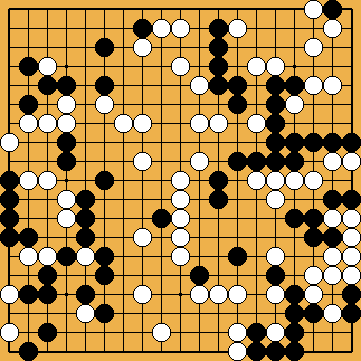
    Problem 4 (the most difficult ever) : Black to play and win the game Problem 4 (the most difficult ever) : Black to play and win the game
(click here for an sgf file of the solution)
If this is supposed to come from a "real game", White must have made a capture (and this only at T6) if it is Black's turn to play ; this could explain a win by 1 point in some variations. I show only the beginning of the solution (with the absurd and yet essential episode during which Black puts her own 20 stones in atari), and the diagram showing the end of the main variation (Black winning by a few points, even though White captured the 20 stones) ; here is also
an animated solution (for once on a separate page), and one complete solution (in French), with commentaries (by Jérome Hubert) ; one will find there amongst other wonders two extraordinary, finely balanced semeais, Black winning for instance the first one 31 liberties against 30, and the second one starting with a 9-stone nakade... It is nevertheless quite possible that this commentary is still incomplete or even wrong (for instance, it doesn't explain the meaning of the stones R19 and S19...) ; I am waiting eagerly for the Chinese commentaries (already published, but not yet translated by Yutopian) ; they seem to have more or less completed their analysis, and lean towards a 3-point victory, and for the Korean ones (in preparation) of the whole of Hatsuyoron.
In 2007, German players studied the problem again, and discovered variations overlooked by everybody, ending in White victory (those were checked by professional players). Then, in 2009, the discovery of a new tesuji (as incredible as everything else) allowed them to rescue Black, but this later idea has not yet been completely confirmed by the pros. I have not really studied their analysis in depth (they may be found at at this adress) ; I will probaly update my sgf files later on... Anyway, it can reasonably be said that the problem is still not solved, which only goes to confirm its unique place in the history of go. New variations were still discovered in 2011 (when they published a book explaining some of their findings) ; starting with one of those, Harry Fearnley constructed a new type of seki, which he called circular hanezeki, solving one of my very old conjectures, as explained here.
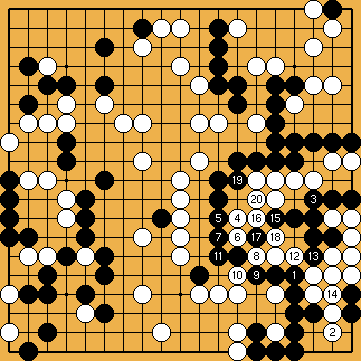
Solution : first skirmishes
(another of the absurd subtleties of the problem is that Black must refrain from sacrificing at 20, to win semeais in (much) later variations...)
|
|

... the above is a hanezeki, that's why Black
can put her own stones in atari
|
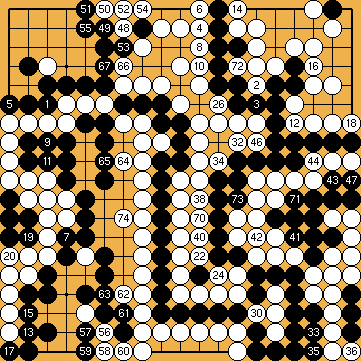
In this variation, Black wins by two points (or maybe only one ?)
|
After seeing this, one must admit that even the most beautiful problems look less impressive...
Back to the table of contents
To Part 2
To Part 3
| Complete history of the bestiary improvements |
|
25/06/05 Problems about rules ; 3 problems from Hatsuyoron (here, there and there) |
|
27/06/05 Warikomis |
|
29/06/05 A new atekomi ; and the complete solution of the lump problem |
|
5/07/05 Completion of the rule section, and some "faeric" problems |
|
6/07/05 A new first line problem |
|
3/08/05 A new tesuji played in a real game |
|
9/09/05 Hayashi Genbi's loose ladder |
|
16/09/05 The raccoon tesuji |
|
19/09/05 Traps and variations in joseki, and a new half-seki |
|
29/01/06 Another new half-seki |
|
11/03/06 Parallel double snapbacks (here, and there) |
|
16/06/06 The Meijin's sorrow : a tesuji missed in a game |
|
24/07/06 Two new ishinoshitas, here and there . |
|
24/03/07 Another "reappearance of the second eye". |
|
8/05/07 Fights involving a bent four. |
|
20/07/07 Sekis with 3 mutual liberties. |
|
5/08/07 New (linear) nakades. |
|
12/08/07 Improvements on the presentation of impossible cuts. |
|
20/08/07 Off-limits moves and phantom go. |
|
22/08/07 Emperor of tsumego revisited. |
|
23/08/07 Star ranking of all problems. |
|
24/08/07 New thoughts in the annex (classification of tesujis, etc.) |
|
Summer 2007 reordering of the first part, more consistent diagram numbers, many minor corrections of references, etc. |
|
23/03/08 A new paradoxical semeai | |
8/04/08 An incredible off-limits sequence. |
|
1/07/08 Two double-threat nakade problems |
|
3/07/08 A more realistic capturing race |
|
10/07/09 "The bait swallows the fish" : Genran's improvement |
|
12/07/09 Genran's seki problem |
|
20/07/09 The seki found by computer |
|
21/07/09 Four variations around the monkey jump | |
22/07/09 Another small snapback problem |
|
3/08/09 New variations in Dosetsu's problem |
|
10/08/09 Ladders : two josekis, O Meien's blunder and a problem from Genran |
|
11/08/09 New variations in the emperor problem |
|
Summer 2009 Rewriting of the introduction and inclusion of sgf files for all problems (first part) |
|
15/11/09 Two 18 stones sacrifices |
|
5/08/10 A complete seki, a pseudo-seki, and some difficult semeais |
|
15/08/10 Appendix B: formal definitions for semeais, seki, etc. |
|
16/08/10 One-sided dames |
| 18/08/11 The emperor problem, again ; rewriting of section I.7 |
|
5/08/12 Circular hanezeki |
|